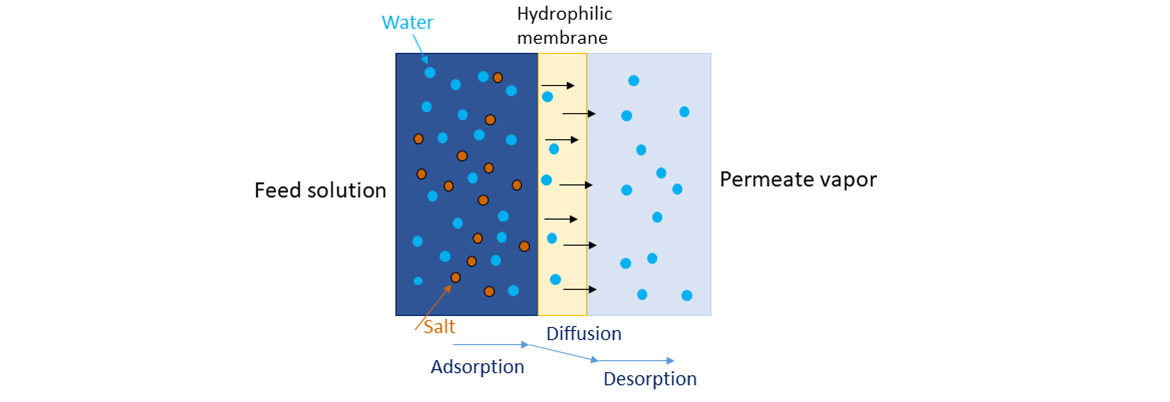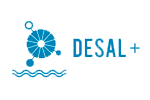Description:
Pervaporation (PV) processes separate mixtures in contact with a membrane via preferential removal of one component from the mixture due to its higher affinity with, and/or faster diffusion through the membrane. The driving force in PV for the mass transfer of permeate is the chemical potential gradient between the feed side and permeate side of the membrane.
Currently, PV is a known technology for dehydration of organic solvents, such as alcohols, removal of dilute organic compounds from aqueous solutions. Recently, it starts to be a point of interest for water desalination.
For desalination purposes, PV involves a hydrophilic dense polymeric membrane or molecularly porous inorganic membrane that is in contact with the feed salt solution
on one side, while the target compound-water preferentially permeates and is removed as vapor from the opposite side. PV is a combination of diffusion of water through a membrane and its evaporation into the vapor phase on the other side
of the membrane to produce fresh water.
Objective:
Desalination via pervaporation has been considered as an attractive membrane process for obtaining fresh water from non-potable saline sources with the advantages of a high rejection of salt and the capability of coping with high-salinity solutions.
Type of water
Seawater.
High salinity brine.
Applications:
Seawater desalination.
Brine/ Hypersaline desalination.
Removal of organics from water.
Separation liquid mixtures.
Zero Liquid Discharge.
Comparison to Established Technologies:
Advantages:
Absence of applied pressure.
High rejection capacity.
Lower operating temperatures.
No limitations on feed water total dissolved solids.
Possibility of utilizing different energy sources, such as waste heat, solar energy and geothermal.
Disadvantages:
Lack of membranes and modules designed.
Low flux.
Performance depends on selection of membrane material.
High energy consumption
Requires pretreatment of feed water source.
Applicability:
TRL 3-4
Technological readiness level (TRL), it is an indicator of maturity of a particular technology. TRL is measured on a scale from 1 to 9, 1 being the lowest and 9 being the highest. A TRL of 9 reflects the implementation of an actual system in operational environment.
J.C. Mankins, Technology Readiness Levels. White Paper, April, 1995
Other Issues:
Operation mode:
Vaccum PV
Air sweep Pv
Air gap PV
Direct contact PV
Energy consumption:
Specific energy consumption, as reported in literature varies for different configurations, feed water concentrations, water recovery, salt rejection etc.
Brackish water desalination:
Electrical energy consumption = 0.65 kWh/m3 (electrical energy required for vacuum pump and feed circulation) and thermal energy consumption= 52.7 kWh/m3 (total dissolved solids= 10 g/L, permeate vacuum = 0.85 bar, temperature= 85ºC, recovery= 50%, water flux=23 L/m2h, operation mode = vaccum PV)
References:
J. Wang, D. Tanuwidjaja, S. Bhattacharjee, A. Edalat, D. Jassby, E. M.V. Hoek. Produced Water Desalination via Pervaporative Distillation. Water 12 (2020) 3560.
Research directions:
Membrane fabrication and modification (higher water flux, without decreasing the selectivity).
Optimization of operating conditions.
Efficiency.
Data sources:
- Castro-Muñoz. Breakthroughs on tailoring pervaporation membranes for water desalination: A review. Water Research 187 (2020) 116428.
- Prihatiningtyas, B. Van der Bruggen. Nanocomposite pervaporation membrane for desalination. Chemical Engineering Research and Design 164 (2020) 147–161.
- Wang, D. Tanuwidjaja, S. Bhattacharjee, A. Edalat, D. Jassby, E. M.V. Hoek. Produced Water Desalination via Pervaporative Distillation. Water 12 (2020) 3560.
- Kaminski, J. Marszalek, E. Tomczak. Water desalination by pervaporation – Comparison of energy consumption. Desalination 433 (2018) 89–93.
- Wang, N. Li, B. bolto, M. Hoang, Z. Xie. Desalination by pervaporation: A review. Desalination 387 (2016) 46–60.
- A. Subramani, J.G. Jacangelo. Emerging desalination technologies for water treatment: A critical review. Water Research 75 (2015) 164-187.


